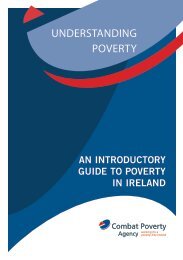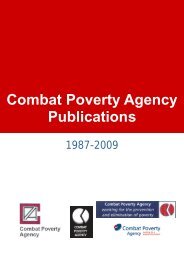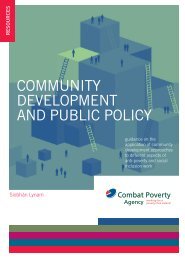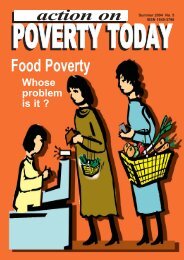Evaluating Integrated Responses to Educational Disadvantage (2000)
Evaluating Integrated Responses to Educational Disadvantage (2000)
Evaluating Integrated Responses to Educational Disadvantage (2000)
- No tags were found...
Create successful ePaper yourself
Turn your PDF publications into a flip-book with our unique Google optimized e-Paper software.
Killinarden <strong>Educational</strong> Network, Tallaght, Dublin (KEN)BackgroundKillinarden Education Network (KEN) is located in an area of West Tallaght in South County Dublin. Killinardenconsists primarily of local authority housing and was built in the late 1970s/early 1980s. Approximately 7,000people live in the area. Almost half of the population are aged less than 20 years. It is located within apartnership company catchment area under the Local Development Programme. The area has high rates ofunemployment, deprivation and low educational attainment.When notice of the Combat Poverty Programme was issued, local organisations, in particular the TallaghtYouth Service, Tallaght Partnership Company and the Killinarden Community School, decided <strong>to</strong> make a jointsubmission.AimsOriginally the programme was seen as an opportunity for each organisation <strong>to</strong> fulfil its own goals but with thesame general target group in mind. A lot of innovative work concerning young people and education wastaking place in the area and the lack of linkages between these needed <strong>to</strong> be more effectively tackled. TheDemonstration Programme was seen as providing this opportunity.StructureBecause of the youth service's prior direct involvement with young people in Killinarden, it was agreed that itshould become a lead organisational structure for the network, with a steering committee made up of it andother network members. The steering committee was subsequently expanded <strong>to</strong> include more parents andmeeting times were changed <strong>to</strong> suit parental participation.ActivityDuring its first phase, Killinarden Education Network's steering committee got a consultant <strong>to</strong> undertake astudy of the area and <strong>to</strong> compile an action plan on behalf of the network. The research involved discussionswith local people, organisations and groups <strong>to</strong> identify issues concerning educational disadvantage and <strong>to</strong>make recommendations around objectives and actions. This action plan was presented <strong>to</strong> local people at apublic meeting in May. It emphasised the need <strong>to</strong>:* develop at a local level a common understanding of educational disadvantage;* identify, implement and support suitable local interventions; and,* formulate policy proposals based on these experiences.Overall, there was slow progress in developing the network until a co-ordina<strong>to</strong>r was appointed in September1997. Thereafter, progress improved and key local educational players were included quite quickly.In the three months after it appointed a co-ordina<strong>to</strong>r, the network arranged meetings with localschool/parents' groups, members of residents'/tenants' associations and with community groups, both <strong>to</strong>inform them about the network and <strong>to</strong> promote their involvement. Membership of the network expanded <strong>to</strong>include representatives from parents, primary and post-primary schools, youth training, youth service, thepartnership company and community, voluntary and religious leaders.Some committee training <strong>to</strong>ok place but overall the committee focused on 'learning by doing' and engagedin ongoing self-evaluation. Although self-evaluation was quite complex, it helped the steering group <strong>to</strong> workthrough issues and <strong>to</strong> understand the reality of what it takes <strong>to</strong> get things going. Understanding the potentialof KEN's co-ordinating role, as distinct from managing interventions, was a significant learning stage.( <strong>Evaluating</strong> <strong>Integrated</strong> <strong>Responses</strong>O













